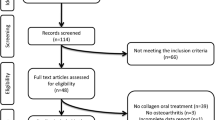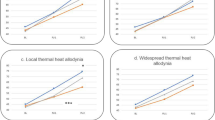Abstract
Introduction
Cognitive behavioral therapy (CBT) is an effective treatment for reducing the pain of knee osteoarthritis (OA) and improving joint function. However, there are few studies on the effect of CBT on the pain severity after total knee arthroplasty (TKA). This study investigates the effectiveness of a CBT program on pain, knee function, quality of life, and pain catastrophizing in patients after TKA.
Methods
This was a randomized, parallel-group, controlled trial in which 100 patients with knee osteoarthritis (OA) prepared for TKA were randomly assigned to participate in CBT or usual care group. Evaluation outcomes include Visual Analogue Scale (VAS), Pain Catastrophizing Scale (PCS), Oxford Knee Score (OKS), Knee Range of Motion (ROM), EuroQol Five-Dimensional (EQ-5D), and Hospital for Special Surgery (HSS) Knee Rating Scale before and after surgery.
Results
We found that patients in the CBT group had a lower pain during activity from the fifth day (p = 0.003) to the third month (p = 0.019) after TKA. At the 12th month, the mean VAS score during activity in the CBT and usual care groups decreased from 4.5 to 0.8 and from 4.6 to 0.9, respectively, and there is no significant difference between the two groups. The PCS scores of patients in the CBT group were lower than those in the usual care group at 1st (p = 0.014) and 3rd months (p = 0.027) after surgery. No statistically significantly differences between the two groups in pain during rest, knee ROM, EQ-5D, OKS, and HSS.
Conclusions
The CBT program was superior to usual care in reducing post-operative pain during activity from the fifth day to the third month and pain catastrophing in the first three months after TKA but has no statistically significantly differences in pain during rest, knee ROM, EQ-5D, OKS, and HSS.
Trial registration
Current Controlled Trials ChiCTR2000032857, date of registration: May, 14, 2020, retrospectively registered.



Similar content being viewed by others
Data availability
All data generated or analyzed during this study are included in this published article.
References
Edwards RR, Haythornthwaite JA, Smith MT, Klick B, Katz JN (2009) Catastrophizing and depressive symptoms as prospective predictors of outcomes following total knee replacement. Pain research & management 14:307–311. https://doi.org/10.1155/2009/273783
Baker PN, van der Meulen JH, Lewsey J, Gregg PJ (2007) The role of pain and function in determining patient satisfaction after total knee replacement. Data from the National Joint Registry for England and Wales. J Bone Joint Surg Br 89:893–900. https://doi.org/10.1302/0301-620x.89b7.19091
Beswick AD, Wylde V, Gooberman-Hill R, Blom A, Dieppe P (2012) What proportion of patients report long-term pain after total hip or knee replacement for osteoarthritis? A systematic review of prospective studies in unselected patients. BMJ Open 2:e000435. https://doi.org/10.1136/bmjopen-2011-000435
Puolakka PA, Rorarius MG, Roviola M, Puolakka TJ, Nordhausen K, Lindgren L (2010) Persistent pain following knee arthroplasty. Eur J Anaesthesiol 27:455–460. https://doi.org/10.1097/EJA.0b013e328335b31c
Hirakawa Y, Hara M, Fujiwara A, Hanada H, Morioka S (2014) The relationship among psychological factors, neglect-like symptoms and postoperative pain after total knee arthroplasty. Pain Res Manag 19:251–256. https://doi.org/10.1155/2014/471529
Bierke S, Petersen W (2017) Influence of anxiety and pain catastrophizing on the course of pain within the first year after uncomplicated total knee replacement: a prospective study. Arch Orthop Trauma Surg 137:1735–1742. https://doi.org/10.1007/s00402-017-2797-5
Butler AC, Chapman JE, Forman EM, Beck AT (2006) The empirical status of cognitive-behavioral therapy: a review of meta-analyses. Clin Psychol Rev 26:17–31. https://doi.org/10.1016/j.cpr.2005.07.003
Bennell KL, Ahamed Y, Jull G, Bryant C, Hunt MA, Forbes AB, Kasza J, Akram M, Metcalf B, Harris A, Egerton T, Kenardy JA, Nicholas MK, Keefe FJ (2016) Physical therapist-delivered pain coping skills training and exercise for knee osteoarthritis: randomized controlled trial. Arthritis Care & Research 68:590–602. https://doi.org/10.1002/acr.22744
Eccleston C, Williams AC, Morley S (2009) Psychological therapies for the management of chronic pain (excluding headache) in adults. The Cochrane database of systematic reviews:Cd007407. DOI https://doi.org/10.1002/14651858.CD007407.pub2
Cai L, Gao H, Xu H, Wang Y, Lyu P, Liu Y (2018) Does a program based on cognitive behavioral therapy affect kinesiophobia in patients following total knee arthroplasty? A randomized, controlled trial with a 6-month follow-up. J Arthroplast 33:704–710. https://doi.org/10.1016/j.arth.2017.10.035
Riddle DL, Keefe FJ, Nay WT, McKee D, Attarian DE, Jensen MP (2011) Pain coping skills training for patients with elevated pain catastrophizing who are scheduled for knee arthroplasty: a quasi-experimental study. Arch Phys Med Rehabil 92:859–865. https://doi.org/10.1016/j.apmr.2011.01.003
Birch S, Stilling M, Mechlenburg I, Hansen TB (2020) No effect of cognitive behavioral patient education for patients with pain catastrophizing before total knee arthroplasty: a randomized controlled trial. Acta Orthop 91:98–103. https://doi.org/10.1080/17453674.2019.1694312
Bäck M, Cider Å, Herlitz J, Lundberg M, Jansson B (2016) Kinesiophobia mediates the influences on attendance at exercise-based cardiac rehabilitation in patients with coronary artery disease. Physiotherapy Theory and Practice 32:571–580. https://doi.org/10.1080/09593985.2016.1229828
Zywiel MG, Stroh DA, Lee SY, Bonutti PM, Mont MA (2011) Chronic opioid use prior to total knee arthroplasty. J Bone Joint Surg Am 93:1988–1993. https://doi.org/10.2106/jbjs.J.01473
Post ZD (2015) CORR Insights(®): preoperative opioid misuse is associated with increased morbidity and mortality after elective orthopaedic surgery. Clin Orthop Relat Res 473:2413–2414. https://doi.org/10.1007/s11999-015-4243-8
Dalton JA, Keefe FJ, Carlson J, Youngblood R (2004) Tailoring cognitive-behavioral treatment for cancer pain. Pain management nursing : official journal of the American Society of Pain Management Nurses 5:3–18. https://doi.org/10.1016/s1524-9042(03)00027-4
Darnall BD, Sturgeon JA, Cook KF, Taub CJ, Roy A, Burns JW, Sullivan M, Mackey SC (2017) Development and validation of a daily pain catastrophizing scale. The journal of pain : official journal of the American Pain Society 18:1139–1149. https://doi.org/10.1016/j.jpain.2017.05.003
Paulsen A, Odgaard A, Overgaard S (2012) Translation, cross-cultural adaptation and validation of the Danish version of the Oxford hip score: Assessed against generic and disease-specific questionnaires. Bone & Joint Research 1:225–233. https://doi.org/10.1302/2046-3758.19.2000076
Sullivan PW, Slejko JF, Sculpher MJ, Ghushchyan V (2011) Catalogue of EQ-5D scores for the United Kingdom. Medical decision making : an international journal of the Society for Medical Decision Making 31:800–804. https://doi.org/10.1177/0272989x11401031
Ranawat CS, Insall J, Shine J (1976) Duo-condylar knee arthroplasty: hospital for special surgery design. Clin Orthop Relat Res:76–82
Danoff JR, Goel R, Sutton R, Maltenfort MG, Austin MS (2018) How much pain is significant? Defining the minimal clinically important difference for the visual analog scale for pain after total joint arthroplasty. The Journal of arthroplasty 33:S71-S75.e72. DOI https://doi.org/10.1016/j.arth.2018.02.029
Somers TJ, Blumenthal JA, Guilak F, Kraus VB, Schmitt DO, Babyak MA, Craighead LW, Caldwell DS, Rice JR, McKee DC, Shelby RA, Campbell LC, Pells JJ, Sims EL, Queen R, Carson JW, Connelly M, Dixon KE, Lacaille LJ, Huebner JL, Rejeski WJ, Keefe FJ (2012) Pain coping skills training and lifestyle behavioral weight management in patients with knee osteoarthritis: a randomized controlled study. Pain 153:1199–1209. https://doi.org/10.1016/j.pain.2012.02.023
Birch S, Stilling M, Mechlenburg I, Hansen TB (2017) Effectiveness of a physiotherapist delivered cognitive-behavioral patient education for patients who undergoes operation for total knee arthroplasty: a protocol of a randomized controlled trial. BMC Musculoskelet Disord 18:116. https://doi.org/10.1186/s12891-017-1476-6
McCracken LM, Sato A, Wainwright D, House W, Taylor GJ (2014) A feasibility study of brief group-based acceptance and commitment therapy for chronic pain in general practice: recruitment, attendance, and patient views. Primary Health Care Research & Development 15:312–323. https://doi.org/10.1017/s1463423613000273
Wang Q, Tan G, Mohammed A, Zhang Y, Li D, Chen L, Kang P (2020) Adding corticosteroids to periarticular infiltration analgesia improves the short-term analgesic effects after total knee arthroplasty: a prospective, double-blind, randomized controlled trial. Knee surgery, sports traumatology, arthroscopy : official journal of the ESSKA DOI https://doi.org/10.1007/s00167-020-06039-9
Maheshwari AV, Blum YC, Shekhar L, Ranawat AS, Ranawat CS (2009) Multimodal pain management after total hip and knee arthroplasty at the Ranawat Orthopaedic Center. Clin Orthop Relat Res 467:1418–1423. https://doi.org/10.1007/s11999-009-0728-7
Vendittoli PA, Makinen P, Drolet P, Lavigne M, Fallaha M, Guertin MC, Varin F (2006) A multimodal analgesia protocol for total knee arthroplasty. A randomized, controlled study. J Bone Joint Surg Am 88:282–289. https://doi.org/10.2106/jbjs.E.00173
Author information
Authors and Affiliations
Contributions
Jian-ning Sun did the study and drafted the manuscript. Wang Chen,Yu Zhang,Ye Zhang were involved in the design, main contribution in literature search. Shuo Feng and Xiang-yang Chen were involved in the study design, and made further revision in this manuscript. All authors read and approved the final manuscript.
Corresponding authors
Ethics declarations
Competing interests
The authors declare that they have no competing interests.
Ethics approval
This study was approved by the Ethics Committee of Affiliated Hospital of Xuzhou Medical University, registration number XFYF2016-xjs020-04.
Consent to participate
Informed consent was signed by all participants.
Consent for publication
Not applicable.
Code availability
Not applicable.
Additional information
Publisher’s note
Springer Nature remains neutral with regard to jurisdictional claims in published maps and institutional affiliations.
Rights and permissions
About this article
Cite this article
Sun, JN., Chen, W., Zhang, Y. et al. Does cognitive behavioral education reduce pain and improve joint function in patients after total knee arthroplasty? A randomized controlled trial. International Orthopaedics (SICOT) 44, 2027–2035 (2020). https://doi.org/10.1007/s00264-020-04767-8
Received:
Accepted:
Published:
Issue Date:
DOI: https://doi.org/10.1007/s00264-020-04767-8




